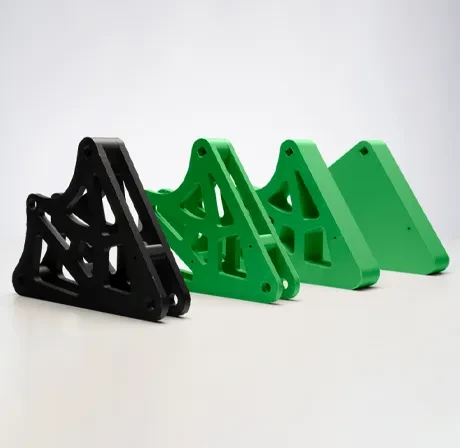
PLA, short for Polylactic Acid, is a versatile material renowned for its impact resistance, strength, transparency, and biodegradability. Widely utilized in Fused Deposition Modeling (FDM) 3D printing, PLA offers enhanced mechanical properties compared to standard PLA, expanding its applicability across various domains.
Derived from renewable resources like corn starch or sugarcane, PLA maintains its eco-friendly nature, making it an environmentally conscious choice. Easy to work with and boasting a spectrum of vibrant colors, PLA stands out as a preferred material for diverse applications.
PLA is widely used for producing prototypes and conceptual models due to its ease of use and good surface finish.
PLA can be used to create functional parts that require moderate strength and durability. It is suitable for low-stress applications such as custom fixtures, brackets, and housings.
PLA is popular among educators, students, and hobbyists due to its ease of printing and wide color availability. It is commonly used for educational models, artistic sculptures, and DIY projects.
PLA is ideal for creating artistic and decorative objects such as figurines, sculptures, vases, and ornaments. Its ability to achieve vibrant colors and smooth finishes makes it attractive for artistic applications.
PLA can be used to produce consumer products such as phone cases, kitchenware, household items, and accessories. It offers a balance of aesthetics and functionality.
PLA is suitable for producing eco-friendly packaging materials. It can be used to create trays, containers, and display cases for products.
PLA is often utilized in the cosplay and entertainment industry to create costumes, props, and accessories. Its ability to achieve intricate details and lightweight structures makes it a preferred choice.
PLA is commonly used to create architectural models and scaled prototypes. Its ability to showcase fine details and smooth surfaces helps visualize design concepts effectively.
PLA is food-safe and biodegradable, making it suitable for applications in the food and beverage industry. It can be used to create food containers, utensils, and disposable cups.
PLA is considered more environmentally friendly than traditional plastics. It is often used in sustainability projects, eco-friendly initiatives, and biodegradable product development.
| Property | Value |
|---|---|
| Tensile Strength | Typically around 50-70 MPa or higher |
| Flexural Strength | Usually in the range of 70-100 MPa or higher |
| Elongation at Break | Typically around 3-8% |
| Density | Approximately 1.24 g/cm³ |
| Glass Transition Temperature (Tg) | Typically around 55-65°C |
| Melting Temperature (Tm) | Typically around 180-210°C |
| Print Temperature | Generally ranges from 190-220°C |
| Bed Temperature | Between 40-60C |
| Thermal Expansion Coefficient | Approximately 60-70 x 10-6/°C |
| Biodegradability | PLA is biodegradable under the right conditions |
SLA 3D printing services offer several advantages:
Exceptional Precision: High resolution and accuracy for intricate details.
Smooth Surface Finish: Minimal post-processing needed for a smooth finish.
Wide Range of Materials: Versatility in material choices for different applications.
Quick Turnaround: Rapid prototyping and production, reducing lead times.
SLA 3D printing is used in various applications, including:
Rapid Prototyping: Creating detailed prototypes for testing and validation.
Medical Devices: Producing biocompatible parts and models for medical applications.
Jewelry Design: Crafting intricate jewelry pieces with fine details.
Engineering Parts: Manufacturing functional engineering components and tools.